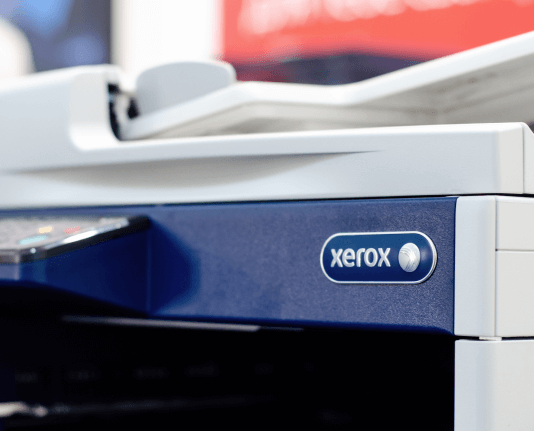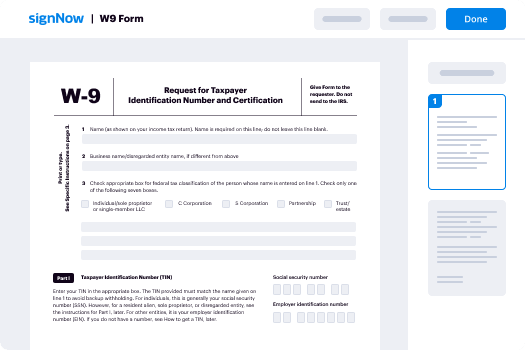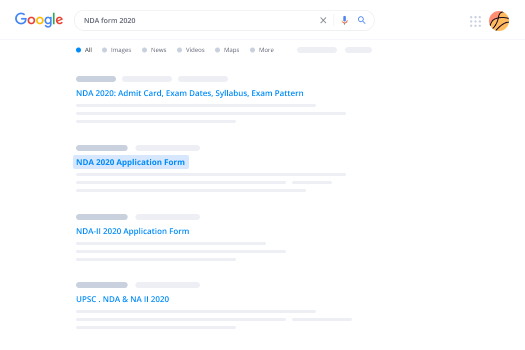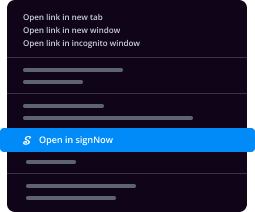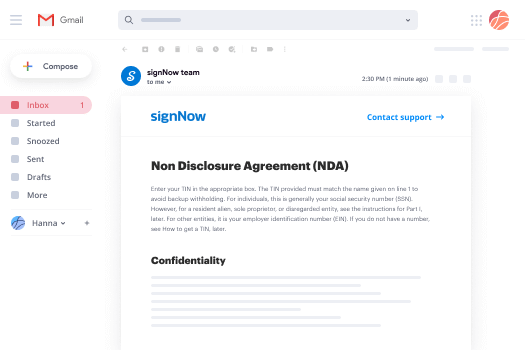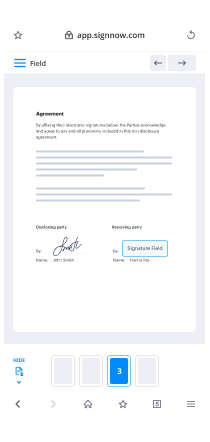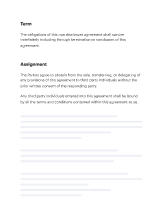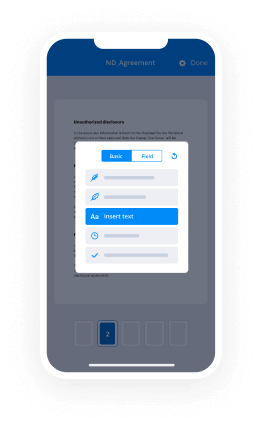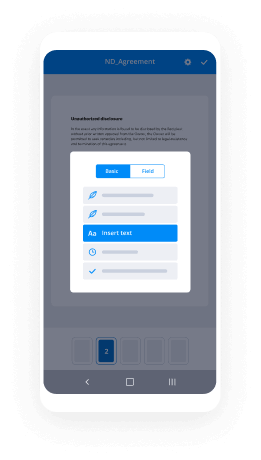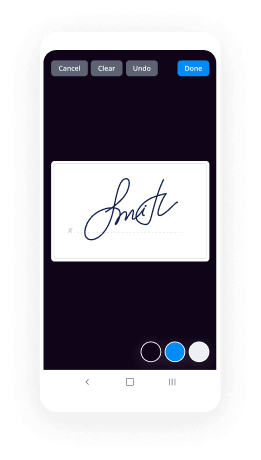How To Integrate eSign in Google Drive
Contact Sales
Make the most out of your eSignature workflows with airSlate SignNow
Extensive suite of eSignature tools
Robust integration and API capabilities
Advanced security and compliance
Various collaboration tools
Enjoyable and stress-free signing experience
Extensive support
Keep your eSignature workflows on track
Our user reviews speak for themselves






Ways to incorporate eSign within Google Drive
Incorporating eSign within Google Drive can improve your document management workflow by enabling you to easily sign and organize documents online. One of the top tools for this is airSlate SignNow, which provides an intuitive interface and robust features designed for organizations of all sizes. This guide will lead you through the straightforward steps to add eSign functionality to your Google Drive process.
Ways to incorporate eSign within Google Drive
- Launch your web browser and go to the airSlate SignNow website.
- Sign up for a free trial or log into your existing account if you have one.
- Choose the document you want to sign or send for signatures and upload it to the service.
- If you intend to use this document often, convert it into a reusable template.
- Access your uploaded document and personalize it by adding fillable fields or inserting required information.
- Include your signature and create signature fields for any signers who need to authenticate the document.
- Press the 'Continue' button to adjust settings and issue the eSignature invitation.
By adhering to these instructions, you can effectively integrate eSign features into your Google Drive arrangement, facilitating your document signing procedure. airSlate SignNow not only makes eSigning easier but also delivers excellent value with its extensive features crafted for small to mid-sized enterprises.
Start using airSlate SignNow today to benefit from its clear pricing and round-the-clock support, ensuring that your document signing process is seamless and efficient. Initiate your free trial now and revolutionize the way you manage your documents!
How it works
Rate your experience
-
Best ROI. Our customers achieve an average 7x ROI within the first six months.
-
Scales with your use cases. From SMBs to mid-market, airSlate SignNow delivers results for businesses of all sizes.
-
Intuitive UI and API. Sign and send documents from your apps in minutes.
A smarter way to work: —how to industry sign banking integrate
FAQs
-
What is airSlate SignNow and how does it help with eSigning?
airSlate SignNow is an intuitive platform that empowers businesses to send and eSign documents quickly and efficiently. It simplifies document workflows, making it easier for users to manage their eSigning needs. Learn how to integrate eSign in Google Drive to streamline your document management process.
-
How do I integrate eSign in Google Drive using airSlate SignNow?
To integrate eSign in Google Drive using airSlate SignNow, you simply need to connect your Google Drive account within the SignNow platform. This allows you to access your documents directly from Google Drive and send them for eSignature seamlessly. Follow the setup instructions provided on our website to learn how to integrate eSign in Google Drive.
-
What are the benefits of using airSlate SignNow for eSigning documents?
Using airSlate SignNow for eSigning documents offers numerous benefits, including ease of use, enhanced security, and faster turnaround times. By learning how to integrate eSign in Google Drive, you can streamline your document workflows and reduce delays in the signing process. Additionally, our platform is cost-effective, making it a great choice for businesses of all sizes.
-
Is there a free trial available for airSlate SignNow?
Yes, airSlate SignNow offers a free trial that allows you to explore its features and functionalities, including the ability to integrate eSign in Google Drive. This trial period gives you the opportunity to evaluate how well the platform meets your eSigning needs before committing to a subscription plan.
-
What pricing plans are available for airSlate SignNow?
airSlate SignNow offers a variety of pricing plans to fit different business needs, starting with a basic plan for small teams to more comprehensive options for larger organizations. Each plan includes features that support eSigning, and you can easily learn how to integrate eSign in Google Drive regardless of the plan you choose. Visit our pricing page for detailed information.
-
Can I use airSlate SignNow on mobile devices?
Absolutely! airSlate SignNow is optimized for mobile devices, allowing you to send and eSign documents on the go. Whether you're at the office or out in the field, you can easily learn how to integrate eSign in Google Drive and manage your documents from your smartphone or tablet.
-
What security measures does airSlate SignNow implement for document signing?
airSlate SignNow prioritizes the security of your documents with state-of-the-art encryption and compliance with industry standards. When you learn how to integrate eSign in Google Drive, you can be confident that your sensitive information is protected throughout the signing process.
-
After getting my ass kicked by a drunk driver, what is a really bad ass e-commerce question that I should spend the next day or
What are fashion brands' biggest pain points today? I leave this wide open. Take whatever angle you want and feel free to break it down by functional area. To what degree is 'a good edit' enough in ecommerce? Nastygal and ModCloth are two examples that have done well because they have developed a clear point of view and curated a specific style for a specific demographic. This is what has driven their success . While they have some simple, nuanced additions to their online stores, it's pretty much just the curation that drives people to the store. Yet, with all of the new models emerging, it seems consumers are expecting more than just curation and looking for 'curation plus discount', 'curation plus content plus discount' , 'curation plus subscription', 'curation plus N factors'. What are interesting new ways to blend commerce and content? Business of Fashion just wrote this article on rap video meets ecommerce. There is a HUGE untapped territory leveraging content including video , text, imagery, etc... where it's a blended experience. What are some potential interesting permutations of this?What are trends in manufacturing ? With increasing costs in China, desires for Just-In-Time manufacturing to an extreme, campaigns around increasing US manufacturing , 3D manufacturing , etc... how will manufacturing evolve and what are the challenges associated with these shifts both on a macro and micro level.There seems to be a shift from people going to department stores when they want to find something specifically, similar to Amazon in the online context. However, people tend to frequent vertically integrated stores like J. Crew, Banana Republic, Zara/H&M/Forever 21, etc... when they want to browse and discover. Also, people go to J. Crew because they have trust with the brand but also enough to discover. Though, a lot of the ones I mention also have a lot of physical stores and thus could be successful due to convenience as one factor. Yet, the latter does not seem to have an online-only comparison that's really taken off. To what degree do you think this offline behavioral shift will translate online? Or in another way of saying, will we see more online-only vertically integrated models (e.g. J. Crew) become successful and commonplace online? What are the challenges or differences with this shift online? How can one effectively build a brand online? (follow up to previous) I know you wrote something previously on Brand Psychology, so as a following, how can a brand be build online (e.g. Bonobos, Warby Parker, Everlane, etc...) How large and sustainable is subscription ecommerce? Obviously, you have a connection to Manpacks , and then JustFab today said they will be doing $100M in revenues by end of 2012. However, how sustainable is this given it is extremely challenging to maintain share of the consumer's wallet consistently and delight a customer every month. Which categories will be able to scale and achieve these levels better than others? Also, Shoedazzle's refocus might be a telling data point, so what do you think of that shift?If you want to start manufacturing a good, what is the best way to get started? I've had this conversation with a lot of people, and it is a cagey world with limited resources . I've been helping some folk but have limited actual experience in different component from concept to sample to batch production onward. So, what are different recipes and resources for early stage brand manufacturers : how to do production, how/where to qualify a manufacturer , quality control, etc... I can ask more questions if you like... I have an endless list , and with every answer brings up new questions. If you don't like any or need clarification, please lmk! If you want to answer one of them, I'll go ahead and ask it.Oh, and I have opinions on all of them, so curious to hear your perspectives. Thus, if you write something on one of the aforementioned, it'll hopefully incite me to actually do some more writing (or rap/jam --as you like to call it--with you one of these topics)...
-
Will Asana be able to integrate Google docs/drive?
The real question is, what exactly do you mean by "integrate with Google docs"? Right now you can already login to Asana using your Google credentials and paste links to Google documents in tasks. If other people within your organization are also signed in Asana using their Google credentials (and you've setup sharing for the doc correctly), they'll be able to access it quite easily.That being said, I second the idea. I'm not sure whether the upcoming web hooks feature will provide for this use case, but it would be awesome to be able to look at a Google doc in an additional pane on the right of the Asana screen, moving seamlessly between "what has to be done" (Asana) and "what is being done" (the Google doc).
-
How will Google Drive integrate with Google Docs?
To be honest, I haven't looked into Google Drive at all, but my instinct is that the way it will integrate with Google Docs is to keep a local cache in a folder of all your documents which until now had only existed in the cloud. Dropping a file into the folder will upload it to Google Docs transparently, and similarly creating a file through the web interface will result in it being automatically downloaded onto any devices setup for Google Drive sync. But that's just my instinct, I could be completely wrong.
-
How well does Google Docs and Drive integrate with "SAP ECC (R/3)" ?
There are a lot of questions and a large context relating to the original question post and Holger's response so far; I'll try to concentrate on the actual question for now ("How well does Google Docs integrate with SAP") and see where it goes. Before I start I would point out that for me, "Google Docs" means the whole application suite, not just docs - i.e. Gmail, Contacts, Calendar, Docs, Sites, and so on. To answer the question you need to consider how Google Docs integrates with anything - via HTTP (and HTTPS of course). This is both at the client end (i.e. uploading documents and data from your browser) and also at the server end (i.e. have the backend pull or push data to other systems such as an SAP system). Since SAP has had (for over a decade now) a built-in HTTP server in the form of the Internet Communication Manager (ICM) - fronted by the Internet Communication Framework (ICF) for a convenient developer layer, the possibilities are endless and in this case ideal for integration with Google Docs. Google Docs is powered and glued together in a quite interesting and well thought out way via Google Apps Script, which is essentially server side Javascript with a whole host of APIs and libraries ('services') that you can use for everything from managing Gmail contacts to building fully-fledged UIs that are standalone. Included is the UrlFetchApp service which gives you a capable HTTP client under your control and executing within the context of the Google Docs backend. A combination of the UrlFetchApp service as consumer, and ICF-powered exposure of SAP data as provider, is a pretty good match to provide integration as in the question. On top of this there are two things to consider immediately:- how do make my exposure and consumption of SAP data private and secure?- how do I go about marshalling and controlling the consumption of that data?The first question is easy: use Google's Secure Data Connector (SDC) to build a secure tunnel from within your corporation intranet (where your SAP systems are) up to Google's servers, and then use that specific tunnel back via Google Apps Script to signNow the HTTP port your SAP's ICM is listening on. You can use pretty well thought out SDC configuration at your server end to control what requests are allowed through. The second question is best answered here as 'it depends'. As you'll be consuming SAP data from Google Apps Script, exposing your data and functions in a resource orientated way (ROA, REST) using JSON as a payload representation would be a good choice. This question is probably worth a separate section in Quora, though :-)Once you have a connection to your SAP backends, and can consume data and functions, you can expose that data and functionality in Google Docs in all sorts of ways, not just in the classic 'spreadsheet' model.
-
How much will Google's integration of Google Drive and GMail hurt Dropbox, Box, etc?
I don't think other apps and services will feel any threats at the early days (being now). But overtime if Google can do a good job integrating all their services together (which is clearly what they are trying to do between Drive, Gmail, G+, etc.), they will become an even more dominant platform. The key lies in how well they can execute all the integration across everything, because it is no doubt very complicated. Different Google services have different use cases and different user flows. But it is no secret that Google want all of our data (so does Microsoft, FB and Apple) - so we'll see how that plays out. Personally I think Box will feel the most pain as Box have developed a web collaboration platform that will have to compete against both Google Docs and Microsoft Office 365. Dropbox have at the minimum mastered the user experience for the masses and a superior technology/ux advantage over Box.
-
How do I integrate Slack with Google Drive?
Click on mentioned hyperlink to know about how to integrate Slack with Google Drive -Google Drive for Slack
Trusted esignature solution— what our customers are saying
Get legally-binding signatures now!
Related searches to How To Integrate eSign in Google Drive
Frequently asked questions
How do i add an electronic signature to a word document?
How do you know an electronic signature is real?
How to sign pdf in system viewer?
Get more for How To Integrate eSign in Google Drive
Find out other How To Integrate eSign in Google Drive
- Ds 3032 14926083 form
- Cobell scholarship bfinancialb needs banalysisb cobellscholar form
- R2t4 worksheet pdf form
- Algebra 2 chapter 3 test answer key form
- Woolcock peak flow chart asthma australia form
- 60335 1 pdf form
- Possessed or crazy mental illness across cultures form
- Va form 22 1990e electronic hampton university
- Ferrari 708 form
- Sampe letter of explanation for cash out refinance form
- Ra02 form
- Cfps handbook pdf download form
- Yale fault code 522660 0 form
- Fortitude sacco form
- Rothshield form
- Webmethods version control form
- Cv template macedonian form
- Express scripts prior authorization form 27371794
- Mini clinical evaluation exercise rating form advanced training
- Sppr 76 form

